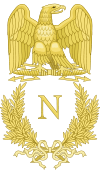Fauj-i-Khas
| Fauj-i-Khas | |
|---|---|
|
Sarkar-i-Khalsa | |
| Active | 1805–1849 |
| Country |
|
| Size | 28,000 (Total), of which 27,000 Sikhs and 1,000 Hindus and Muslims |
| Garrison/HQ | Peshawar garrison, Sutlej garrison |
| Nickname | The Maharaja's own army |
| Patron | Khalsa |
| Motto | Deg Tegh Fateh |
| Colors | Le Tricolore |
| March | La Victoire est à nous |
| Engagements | Afghan-Sikh Wars, Sino-Sikh War, Anglo-Sikh Wars |
| Commanders | |
| Notable commanders |
Hari Singh Nalwa Maharaja Ranjit Singh I of Punjab Gurmukh Singh Lamba Lehna Singh Majithia Dal Singh Nahama Jean-Francois Allard Jean-Baptiste Ventura |
The Fauj-i-Khas was a brigade or battalion of the Fauj-i-Ain section of the Sikh Khalsa Army of Punjab.
History
By the growing power of British in Indian subcontinent, Ranjit Singh started worrying about his Sikh Empire. He once met Irish adventure George Thomas and was surprised to see the discipline and new equipment of his army. He then ordered his generals to train the troops with European muskets, possibly the Brown Bess and Baker rifle. However, his generals were unsuccessful. At that time, Ranjit Singh's men were ununiformed and undisciplined and used Matchlocks, Swords- such as Talwar, Khanda and Shamshir, Lances, Bows and Arrows.
Beginning
It was the Maharaja Ranjit Singh who started to hire European officers to train and command parts of his army. The Fauj-i-Khas was a model brigade trained and equipped after European model under the command of General Jean-Baptiste Ventura. It consisted of 11000 horsemen(Ghor Charras), divided into fifteen Dera led by eminents sardars, among them Sham Singh Atariwala, Gurmukh Singh Lamba, Hari Singh Nalwa, and two by non Sikhs, the Mulraj Derah of Dewan Mulraj and Dorgra Derah of Dhian Dogra.Izazi-i-sardari was the highest honour,most distinguished Sikh generals,sardar Gurmukh Singh Lamba, Hari Singh Nalwa, and Dal Singh Nahama were the recipient.Sikh General Sardar Gurmukh Singh Lamba sketch portrait Painting is displayed at Central Museum Lahore under serial D-40 with a caption.
Size
The Fauj-i-Khas had 4 battalions of infantry, 2 regiments of cavalry and a troop of artillery. The cavalry was built on a British model and the infantry on French pattern. This was the first unit in the army to be equipped European-style. Impressed by its performance, the Maharaja ordered a total reorganisation of his whole regular force on the model of Fauj-i-Khas in 1835. This alarmed the British, who had come to see the emerging military power of Punjab as a threat, to such a degree that they in 1837 issued orders to be vigilant and try to arrest any French officer travelling in disguise to join Ranjit Singh’s army.
Before Ranjit Singh, the Punjab army was mainly a pure cavalry army. Under the supervision of the European officers, and encouragement by the Maharaja, the infantry and artillery gained importance, and by the time of the death of Ranjit Singh, the infantry service had become the preferred service in the army.
Commanders
Over the years many Europeans served in the army of the Punjab. Among them:
- General Jean-François Allard (cavalry) - French
- General Paolo Di Avitabile (infantry) - Italian (Naples)
- General Jean-Baptiste Ventura (infantry) - Italian (Modena)
- General Claude August Court (artillery) - French
- Colonel Alexander Gardner (artillery) - American (Wisconsin)
- Colonel John Holmes - Anglo-Indian
Sources
- Major Pearse, Hugh; Ranjit Singh and his white officers. In Gardner, Alexander (1999) [1898]. The Fall of Sikh Empire. Delhi, India: National Book Shop. ISBN 81-7116-231-2.
- Fauj-i-khas Maharaja Ranjit Singh and His French Officers, by Jean Marie Lafont. Published by Guru Nanak Dev University, 2002. ISBN 81-7770-048-0.
- The Sikh Army 1799-1849 By Ian Heath, Michael Perry
- Maharaja Ranjit Singh By Jean Marie Lafont (Page 59,146,148)
